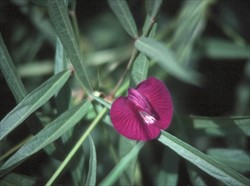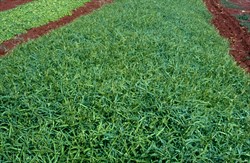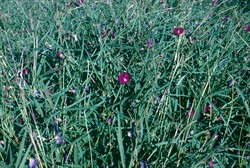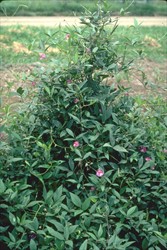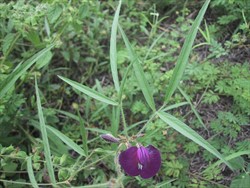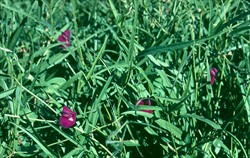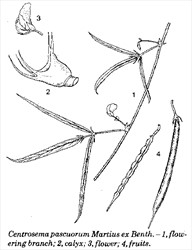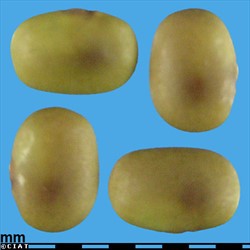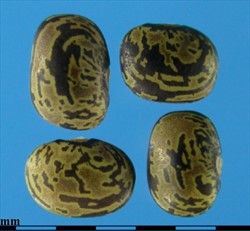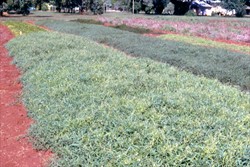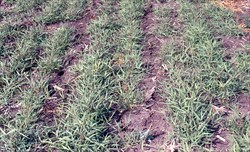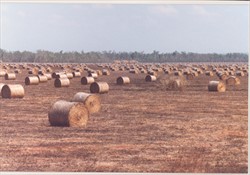Centrosema pascuorum
Tropical Forages
Family: Fabaceae (alt. Leguminosae) subfamily: Faboideae tribe: Phaseoleae subtribe: Clitoriinae.
An annual, twining herb that can root from the nodes of trailing stems under moist conditions. Stems cylindrical, glabrous or scarcely pilose, extending up to 2 m from the crown. Leaves trifoliolate, often held erect and paraheliotropic especially during dry periods. Petioles 25‒50 mm long, glabrous to scarcely pilose. Leaflets of the Australian cultivars are long (50‒100 mm) and narrow (5‒10 mm) giving a sward, from some distance, a grass-like aspect; however, in the available germplasm collection there exists also great variation in leaflet shape. Inflorescence racemose; flowers borne singly or in pairs at the end of a short peduncle; corolla is wine red to crimson, 15‒25 mm long and wide. Flowers predominantly self-pollinated. Pod linear to slightly curved, 4‒8 cm long and 3‒4 mm wide, laterally compressed with a dark longitudinal stripe, containing up to 15 seeds and shattering violently at maturity up to 1 m wide thus allowing dispersal of seeds. Seeds ovoid to cylindrical, approx. 4 mm long, greenish-yellow to brown and rarely mottled. 34,500–147,000 seeds/kg (48,000 seeds/kg in cv. Cavalcade; 58,000 seeds/kg in cv. Bundey).
Native:
Northern America: Mexico (Chiapas, Oaxaca, Tabasco)
Central America: Costa Rica; El Salvador; Guatemala; Honduras; Panama
South America: Brazil (Alagoas, Bahia, Ceará, Mato Grosso, Mato Grosso do Sul, Minas Gerais, Paraíba, Pernambuco, Piauí, Rio Grande do Norte, São Paulo, Sergipe); Ecuador (Guayas); Guyana; Venezuela (Anzoátegui, Aragua, Bolívar, Cojedes, Falcón, Federal District, Guárico, Miranda, Monagas, Zulia)
Cultivated:
Asia: Indonesia; Malaysia; Papua New Guinea; Philippines; Thailand
Australasia: Australia (Northern Territory)
Central America: Nicaragua
Forage
Suitable for mixtures with grasses, or in pure stands for ley-farming such as in fodder banks in Nigeria. It makes excellent hay. In the Northern Territory, Australia, cv. Cavalcade hay is grown to produce legume cubes (pellets): Hay giving yields of about 7 t/ha is cut with a rotary head cutter and dried in the field to 10% moisture. Bales are shredded and mixed with bentonite (a volcanic-ash clay material containing Fe, Mg and either Na or Ca), sprayed with water to 12% moisture and then cubed under very high pressure. 'Cavalcade' hay and pellets provide feed on boats for live cattle exported from Darwin to Indonesia and the Philippines. Stands persist through a seed bank and for hay production, renovation every 3 or 4 years is recommended to maintain a pure stand.
Soil requirements
Adapted to a wide range of soils, from sand to heavy clay and from slightly acid to alkaline soils (pH 5‒8.5). Requires medium to high soil fertility.
Moisture
Annual rainfall at collection sites is between 350 and 1,500 mm (usually below 1,000 mm), with 4‒10 dry months. Occasionally, it is found at sites with some seasonal flooding stress e.g. in the Pantanal of Brazil. Thus, the species is considered suitable for tropical areas with pronounced dry seasons of up to 8 months and 700‒1,500 mm annual rainfall. Though individual plants die off under drought conditions, populations persist through escape mechanisms such as annual life span, rapid growth and flowering, and high seed production. Morphologically, the narrow leaflets and phototropism (i.e. erect leaves oriented towards sunlight), osmotic and stomatal adaptation are also adaptation mechanisms to drought.
Temperature
Being a tropical lowland species and found naturally at altitudes between 20 and 1,000 m asl, frost tolerance is poor.
Light
No information available.
Reproductive development
Not much information is available on photoperiod response but flowering time appears to be related to sites of origin; cv. Cavalcade is known to be a short day plant.
Defoliation
Moderate tolerance to grazing and cutting.
Fire
No information available. Being an annual, plants will probably not survive a fire but the population will regenerate from soil seed reserves (250 kg/ha).
Guidelines for establishment and management of sown forages.
Establishment
Seed scarification (heat treatment or sulphuric acid) is advisable to reduce hardseededness. In soils without previous legume cultivation, responds to inoculation with appropriate rhizobium and mycorrhiza. In Colombia, nearly three times more N was produced with inoculation compared with uninoculated plants. Strain CB 1923 is highly effective. Seeding rates used are 2‒6 kg/ha. For seed production and hay crops of cv. Cavalcade in Australia, seeding rates up to 10‒15 kg/ha are reported to ensure good plant stands. Some soil disturbance is crucial to ensure good establishment. is best sown, drilled or broadcast, in a cultivated seed bed at a depth of 1‒2 cm. Best time for sowing is the start of the wet season. It is advisable to control weeds during establishment.
Fertilizer
Superphosphate fertilization will enhance establishment and growth. Depending on soil conditions, for establishment 100‒250 kg/ha, for maintenance 50‒100 kg are recommended. In ley-farming, the phase is able to provide 80‒100 kg/ha N to the system.
Compatibility (with other species)
At establishment, competes well with weeds if seeding rate is high enough.
Companion species
Grasses: Andropogon gayanus, Cenchrus ciliaris, Megathyrsus maximus, Setaria sphacelata, Urochloa decumbens, .
Pests and diseases
A number of diseases and pests have been reported for , however without causing major damage, e.g. little leaf mycoplasma, centrosema mosaic virus and other diseases such as Cercospora canescens (leafspot), Colletotrichum truncatum (anthracnose), Pseudocercospora bradburyae (leaf spot), Rhizoctonia solani (foliar blight) and Neocosmopora vasinfecta, also sucking insects during seed production. Susceptibility to root knot nematodes (Meloidogyne spp.) needs to be taken into account when is to be used in rotation with crops. Pagria flea beetle (Pagria sp.) has been reported to cause severe damage in northern Australia in both cvv. Bundey and Cavalcade.
Ability to spread
Self-regenerating annual, adventitious roots on trailing stems.
Weed potential
No information available; probably none or low.
Nutritive value
is a high quality forage. Crude protein content and digestibility vary according to plant age and season (6‒27% and 42‒79%, respectively). Mineral concentrations are similar to .
Palatability/acceptability
is highly palatable.
Toxicity
No information available; probably none.
Dry matter
For pure stands, DM yields of 4‒9 t/ha are reported.
Animal production
In Australia, daily liveweight gains of 460‒540 g/animal during the main dry season and in three consecutive years of cattle on a cv. Cavalcade ley pasture, in comparison with liveweight losses of 140‒240 g/animal on native pasture. Also in semi-arid/dry sub-humid Northern Territory (Australia), remained the dominant pasture component after 5 years of stocking at 3.3 steers/ha, consistently producing dry-season liveweight gains of 20‒50 kg/ha.2n = 22. Self-pollinating species. Selection emphasis in Australia is on forage yield and flowering date. Cv. Cavalcade is the result of an Australian breeding program (1976‒1981), which aimed at the development of a cultivar with high forage and seed yields, and nematode resistance.
flowers 2‒5 months after sowing. In one study, a negative correlation between seed yield and time to flowering was found, but there was no consistent relationship between seed yield and seed size.
For seed production well-drained sandy loams are best suited. At least 5 kg/ha seed are sown, with fertilization according to soil properties: a general recommendation is 150‒250 kg superphosphate/ha for establishment, and 100‒150 kg superphosphate/ha and 50‒100 kg muriate of potash/ha for maintenance. For reliable seed production cvv. Cavalcade and Bundey need rainfall of at least 1,000 and 1,100 mm, respectively. Seed is suction-harvested (slow and energy consuming), or stands are mown prior to pod shattering followed by use of conventional harvester. Seed yields of 250‒1,500 kg/ha are reported.
No information available.
- High-quality forage for pastures and ley farming, production of hay and legume cubes.
- Well adapted to the dry tropics, tolerates seasonal flooding and adapts to a wide range of soil conditions including heavy clays but excluding very acid, low-fertility soils.
- Self-regenerating annual that grows and spreads rapidly.
- High seed production.
- Being an annual, its persistence depends on an adequate soil seed reserve.
- For ley farming, susceptibility to root-knot nematodes can be a limitation.
- Not well adapted to acid, infertile soils.
Clements, R.J. (1992) Centrosema pascuorum Martius ex Benth. In: Mannetje, L.’t and Jones, R.M. (eds) Plant Resources of South-East Asia No. 4. Forages. Pudoc Scientific Publishers, Wageningen, the Netherlands. p. 86–88. edepot.wur.nl/327785
Clements, R.J., Winter, W.H. and Thomson, C.J. (1986) Breeding Centrosema pascuorum for northern Australia. Tropical Grasslands 20:59–65. goo.gl/IA8ULS
McCosker, T.H. (1987) Agronomic and grazing evaluation of 3 lines of Centrosema pascuorum under seasonally flooded conditions in the Northern Territory. Tropical Grasslands 21:81–91. bit.ly/3dtWsBf
Schultze-Kraft, R. and Clements, R.J. (eds). (1990) Centrosema: Biology, agronomy, and utilization. CIAT Publication No. 92. Centro Internacional de Agricultura Tropical (CIAT), Cali, Colombia. hdl.handle.net/10568/54383.
Thiagalingam, K., Zuill, D. and Price, T. (1997) A review of Centrosema pascuorum (centurion) cvv. Cavalcade and Bundey as a pasture legume in the ley farming system studies in North West Australia. Proceedings of the XVIII International Grassland Congress, Winnipeg & Saskatoon, Canada, 8–17 June 1997. p. 43–44.
Thomson, C.J., Clements, R.J. and Schultze-Kraft, R. (1997) An evaluation of seventy-one accessions of Centrosema pascuorum at Katherine, Northern Australia. Genetic Resources Communication No. 25. CSIRO Tropical Agriculture, St Lucia, Australia. bit.ly/3apsWdN
'Cavalcade' Released in Australia (1984). A bred line, for the semi-arid tropical regions with a 5‒8 months dry season.
'Bundey' (CPI 75115) Australia (1986). Origin: Paraíba State, Brazil; late-flowering, suited to wet-dry tropical regions, seasonally flooded for long periods. Provides valuable dry season grazing.
None reported.
